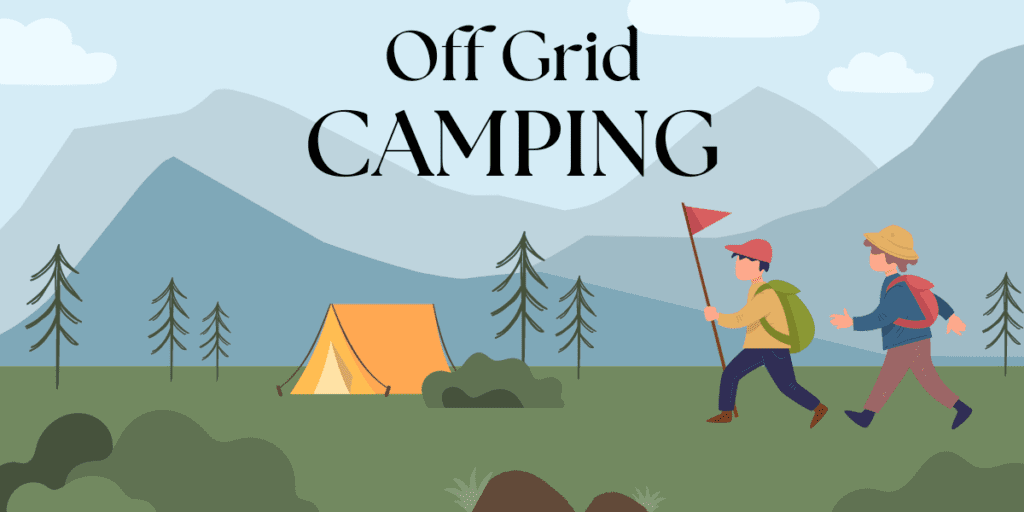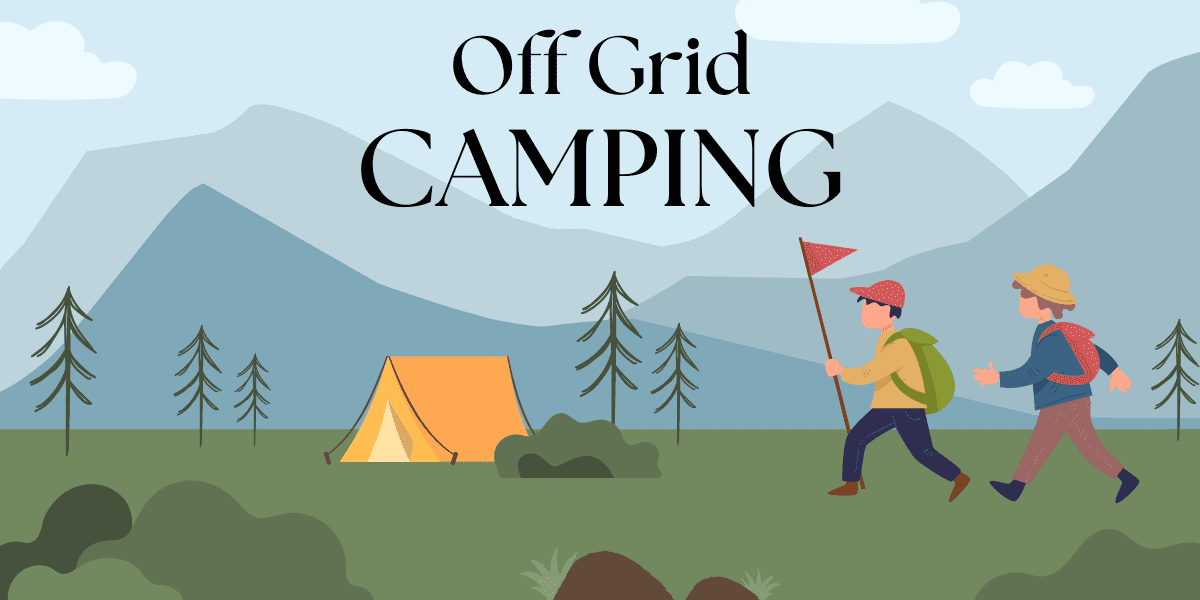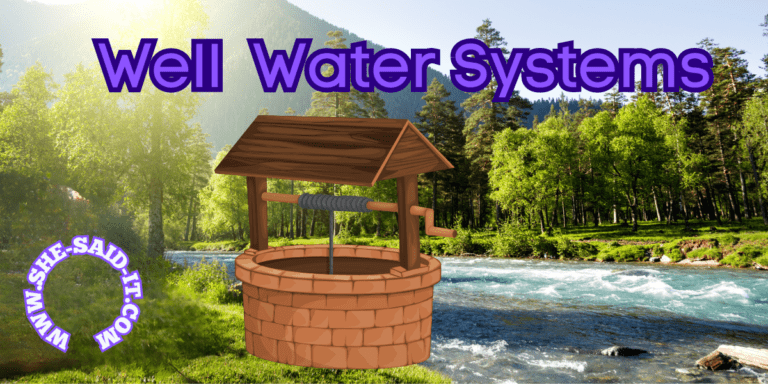Off Grid Camping: From Basic to Boujee – Your Ultimate Guide

Untamed Adventures: Unraveling the Differences between Off-Grid Camping and Boondocking
Off-grid camping and boondocking are similar in many ways, but they do have some differences primarily based on the type of camping and the location.
Off Grid Camping
This generally refers to camping in a manner that doesn’t rely on the traditional infrastructure of established campgrounds, such as electricity, water hookups, restrooms, and other amenities. This can be done in a variety of locations, including both designated camping areas and more remote wilderness settings.
This style of camping can involve tent camping, hammock camping, car camping or even camping in a van or RV, but without the use of any amenities or campground infrastructure. It often requires a higher degree of self-sufficiency, including bringing all necessary supplies, generating your own power (if needed), and practicing strict leave-no-trace principles.
Boondocking
Boondocking, also known as dry camping or dispersed camping, specifically refers to camping in an RV not at developed campground. One without any water, electricity, or sewer hookups. The term is often used to describe free camping in remote locations, away from traditional campgrounds. This might include places like BLM (Bureau of Land Management) land and other public lands in the United States, where it’s legal to camp for free.
The main difference lies in the fact that people who boondock is exclusively related to RVs or van camping without hookups, often in more remote locations, while off-grid camping can encompass a wider variety of camping styles and locations, but always without the reliance on campground amenities or infrastructure.
1. Into the Wild: The Allure of Off-Grid Camping
There’s a certain magic to going off the grid. To stepping away from the daily grind, the constant pings of notifications, and embracing the tranquillity of nature. This is the essence of off grid camping.
This type of primitive camping is more than just a weekend getaway; it’s a lifestyle choice. It’s about being self-sufficient, responsible, and respectful of the environment while finding a new appreciation for life’s simplest pleasures. It’s about trading the hum of air conditioning for the whispering wind, and replacing the harsh glare of screens with the gentle glow of a campfire.
In recent years, this style of camping and car camping has gained popularity for just these reasons. More and more people are seeking out the serenity and adventure that comes from venturing off the beaten path. This growing trend is part of a larger societal shift towards embracing a slower, more mindful pace of life. It’s about unplugging from the digital world and tuning into the natural one. It’s also significantly cheaper than regulated forms of camping. The rise of popularity of living the full time RV life has seen a dramatic rise in prices of campgrounds and RV parks. Trust me I went full time in 2009 and the insane levels of inflation did not pass by the RV lifestyle.
But don’t be fooled – rustic camping isn’t all hammocks and hot cocoa. It requires careful planning, preparation, and a willingness to get your hands dirty. But trust us, the rewards far outweigh the challenges. In this guide, we’ll take you through everything you need to know to have a successful, enjoyable, and safe off grid camping experience, from the essential gear you’ll need to the best ways to cook up a feast in the wilderness. Whether you’re a seasoned camper or a complete beginner, there’s something in here for you.
So, are you ready to step into the wild? Let’s dive in!
2. Back to Basics: Essential Gear for Camping off The Grid
Venturing off the grid requires a shift in thinking. When you’re miles away from the nearest convenience store, forgetting an essential item can be more than just an inconvenience. But don’t worry – we’ve got you covered. Below is a breakdown of the essential gear you’ll need for a successful camping trip.
1. Shelter and Comfort: The first items on your checklist should be related to where you’re going to sleep. A robust, weather-appropriate tent is a must-have. You’ll also need a cozy sleeping bag rated for the expected temperatures of your camping location and season. An inflatable or roll-up sleeping pad can add extra comfort and insulation. Don’t forget a good-quality camping pillow for a good night’s sleep!
2. Clothing: Dressing in layers is key for camping. Pack lightweight, moisture-wicking clothing for warm weather and daytime hiking, and warmer layers for cooler nights. Always pack a waterproof jacket, sturdy hiking boots, and bring exra socks!
3. Food and Water: Plan your meals ahead of time, opting for non-perishable foods like canned goods, pasta, and rice. High-protein snacks like trail mix and jerky are also great options. As for water, a good rule of thumb is to bring a minimum of one gallon per person per day for drinking and cooking. Check out my blog post about water filters.
4. Cooking Gear: You’ll need a portable camping stove, fuel, and a lighter or matches for cooking. A pot, pan, cooking utensils, and a cooler to keep perishables fresh are also essential. Don’t forget biodegradable soap, a sponge, and a basin for washing dishes.
5. First Aid and Safety Essentials: A well-stocked first-aid kit is a must-have for any camping trip. Make sure it includes band-aids, antiseptic wipes, tweezers, medical tape, pain relievers, and any personal medication. Also consider bringing a multi-tool or Swiss Army knife, a whistle for emergencies, a map and compass for navigation, and bear spray if you’re in bear country.
Remember, the key to successful off-grid camping is to plan carefully, pack wisely, and always respect nature’s rules. With these essential items, you’ll be well on your way to a memorable camping experience. Happy trails!
3. Let There Be Light (and Heat): Managing Off-Grid Energy
When you’re camping off grid, managing your energy resources effectively is essential. From keeping your devices charged to cooking meals and staying warm, here’s what you need to know:
1. Solar Power for Camping: Harnessing the power of the sun is an excellent way to keep your devices charged and your lights on. Portable solar panels are a popular choice for many dispersed campers. These lightweight, foldable panels can be set up during the day to charge a portable power bank, which can then be used to power your devices.
You can also invest in solar-powered chargers for smaller devices like phones, tablets, or e-readers. Solar lanterns and lights can also be a great addition, providing you with illumination during the night without draining your power bank.
2. Cooking Options: When it comes to cooking, you’ll want a reliable and portable solution. A small propane camping stove is a popular choice for its ease of use and control. For a more traditional camping experience, a portable fire pit or grill can also be used.
If you’re using a fire pit, remember to follow safe fire practices, including checking for any fire bans in the area, keeping water nearby to extinguish the fire, and never leaving it unattended. And always ensure that your fire is completely out before retiring for the night or leaving your spot.
3. Keeping Warm: Even during the summer, nights can get chilly when you’re camping. Staying warm is not just a matter of comfort, but also a safety issue. Dress in layers using moisture-wicking materials to keep dry and warm. A good quality sleeping bag rated for the lowest expected temperature is essential.
Consider bringing a thermal blanket for extra warmth or in case of emergencies. It’s also a good idea to pack a hot water bottle which can be filled and put in your sleeping bag on particularly cold nights.
If you’re using a fire for warmth, remember to follow all safety guidelines and never leave the fire unattended. After all, the call of the wild shouldn’t include a visit from the local fire department!
Remember, managing your energy while camping requires careful planning and preparation. But with the right gear and practices, you can enjoy the beauty and tranquillity of nature while keeping your devices charged, your belly full, and your body warm. Happy camping!
4. H2-Oh Yeah: Water Management in the Wilderness
Water is the elixir of life, and when you’re camping, managing your water supply is of utmost importance. From hydration to cooking and cleanliness, here’s what you need to know about water management in the wild:
1. Water Supply: The amount of water you’ll need largely depends on the activities you’ll be engaging in and the climate of your camping location. However, a good rule of thumb is to carry at least one gallon of water per person per day for drinking and cooking. Always carry extra in case of emergencies.
2. Locating Water: If you’re camping near a natural source like a river or lake, you might be able to supplement your supply. Be aware, however, that open sources can be home to bacteria and parasites. Never consume water directly from an open source without treating it first.
3. Water Treatment: There are various methods to treat water and make it safe for consumption. Boiling is one of the most effective methods – just make sure the water has been at a rolling boil for at least one minute.
Water purification tablets are another lightweight and easy solution. They can kill most types of bacteria, viruses, and protozoa. Check out my blog post about water filter systems here.
Portable water filters or purifiers are also a great option, especially if you plan to rely heavily on natural sources of water. These filters can remove bacteria and protozoa, and some can even filter out viruses.
4. Water Storage: Bringing along durable, leak-proof water containers is crucial. Collapsible water containers can save space and are easy to fill at a source of water. Remember, it’s better to have multiple smaller containers rather than one large one in case it gets damaged or lost.
5. Water Conservation: Be mindful of your water usage. When cleaning dishes, use as little water as possible. Consider using biodegradable wipes for personal hygiene instead of using water. Dawn power wash spray is no rinse required.
6. Respecting Natural Sources of Water:
When you’re camping off the grid, it’s crucial to remember that we’re merely visitors in nature, and it’s our responsibility to leave as minimal an impact as possible. This extends to the way we interact with natural source of water. First and foremost, never pollute these sources with waste or garbage.
When cleaning dishes or yourself, move at least 200 feet away from the water to prevent soap, even biodegradable types, from entering the water. Always use eco-friendly, non-toxic products that won’t harm the environment.
If you need to get rid of cooking water, strain out the food particles and scatter the water over a wide area, well away from the source. This also is good practice to avoid surprise visits from bears, we discuss that more in-depth later.
Remember, many animals and plants rely on these sources of water for survival. By respecting these principles, we can ensure that our love for off grid camping doesn’t harm the ecosystems we so enjoy. After all, the beauty of nature is a privilege to witness, and it’s up to us to help preserve it for future generations of campers.
Staying hydrated is crucial, especially when you’re engaged in physical activities like hiking. Always prioritize having enough water for drinking over cooking or cleaning purposes. With these water management tips, you can ensure you have a safe and successful off-grid camping experience. Stay hydrated, campers!
5. Expect the Unexpected: Preparing for Emergencies Off the Grid
In the great outdoors, it’s important to remember that nature can be unpredictable. While we hope for smooth sailing, it’s always smart to prepare for potential emergencies. From first aid to communication, here’s how to stay safe off the beaten path:
1. First Aid: A well-stocked first aid kit is a non-negotiable when camping. Make sure it includes bandages, antiseptics, tweezers, medical tape, and any personal medication. Knowledge of basic first aid is also essential. Take time before your trip to familiarize yourself with procedures for common issues like sprains, cuts, burns, and insect bites. Here’s a great mini first aid kit from Amazon.
2. Communication: When you’re off the grid, cell service can be unreliable or non-existent. However, there are a few tools you can use to reach out for help in case of an emergency:
- Satellite Phones: These devices bypass cell towers and connect directly to satellites, providing coverage almost anywhere in the world. They can be expensive, but rental options are available for short-term trips. I’m really intrigued by the BivyStick.
- Personal Locator Beacons (PLBs): In a serious emergency, a PLB can be a lifesaver. When activated, it sends a distress signal with your location to search and rescue services via satellite. Pricey, but worth the peace of mind. Here’s the best seller from Amazon
- Satellite Messengers: These devices, like those from SPOT or Garmin’s inReach, allow for two-way communication with emergency services and can send pre-programmed check-in messages to loved ones. Check them out here.
3. Navigation: Always carry a map and compass and know how to use them. GPS devices or apps can also be useful, but remember they may not work without cell reception or if batteries die. Grab a compas guide book here. Grab a compass here.
4. Weather Awareness: Be sure to check the weather forecast before you go, but be prepared for it to change. Bring gear for all possible conditions and know the signs of impending bad weather.
5. Wildlife Encounters: Familiarize yourself with the wildlife in the area and know what to do in case of an encounter. Carry bear spray if you’re in bear country and know how to store food properly to avoid attracting animals. Wear a bear bell it will also deter cougars.
Remember, the key to a successful adventure is preparation. Equip yourself with the right knowledge and tools, and you’ll be ready to tackle any challenges that come your way. Happy and safe camping!
6. Eat, Sleep, Camp, Repeat: Off-Grid Campsite Setup and Maintenance
Your site is your home away from home when you’re camping. The right site can enhance your camping experience, while your efforts to maintain it can preserve the beauty of nature for future campers. Here’s what you need to know:
1. Choosing the Right Campsite: Location is everything when it comes to setting up your camp. Look for a site that’s flat and clear of debris for a comfortable night’s sleep. It should be a safe distance from any water bodies to protect delicate ecosystems and avoid flash floods.
Consider proximity to water and firewood, but remember the importance of respecting nature. Avoid areas with lots of insect activity, especially near standing water which is often a breeding ground for mosquitoes.
2. Setting Up Camp: Once you’ve found the perfect spot, it’s time to set up your camp. Start by pitching your tent on flat, elevated ground to avoid water runoff in case of rain.
Next, establish your kitchen area a reasonable distance from your sleeping area to keep food smells away from where you sleep, reducing the chance of wildlife encounters.
Always follow the manufacturer’s instructions when setting up your gear. Make sure everything is secure, especially if you expect windy conditions.
3. Leave No Trace Principles and Camp Maintenance: The Leave No Trace principles are a set of guidelines for outdoor ethics promoting conservation in the outdoors. Key principles include disposing of waste properly, leaving what you find, respecting wildlife, and being considerate of other visitors.
Make sure to carry all of your trash out with you. Use biodegradable products whenever possible, and get rid of wastewater well away from natural source of water.
When it’s time to leave, dismantle your site and make it look as if you were never there. The goal is to minimize your impact on the environment, preserving the natural beauty for others to enjoy.
Remember, camping is about immersing yourself in nature and leaving the modern world behind. With careful site selection, setup, and maintenance, you can ensure a seamless camping experience while maintaining the integrity of the beautiful outdoors. Happy camping!
7. Outdoor Gourmet: Campfire Cooking 101
There’s something special about cooking over an open fire, under a canopy of trees, with the stars as your ceiling. But campfire cooking is more than just roasting marshmallows. With a few tips and tricks, you can turn your campfire into a gourmet kitchen. Here’s how:
1. Campfire Cooking Techniques and Safety: The key to successful campfire cooking lies in managing your fire and heat effectively. You should wait until your fire has burned down to hot coals – they provide a more consistent and manageable heat than open flames.
For cooking, you might want to consider a campfire grill grate, which can be placed over the fire and provides a stable cooking surface. Always have a fire extinguisher or a bucket of water nearby for safety.
Remember to respect local fire restrictions and always fully extinguish your fire when you’re done.
2. Delicious and Simple Campfire Recipes: Campfire cuisine can go far beyond the classic hot dogs and smores (though those are delicious too!). Here are a few simple recipes to elevate your outdoor dining experience:
- Foil Packet Meals: These are easy, versatile, and require minimal cleanup. Simply place your choice of protein (like chicken, fish, or tofu), vegetables, and seasonings in a foil packet. Seal it up and place it on the hot coals. In 20-30 minutes, you have a delicious, steamed meal.
- Skillet Breakfast Hash: Start your day with a hearty breakfast. In a cast-iron skillet over your fire, cook some diced potatoes until golden. Add in some chopped bell peppers, onions, and pre-cooked sausage or bacon. Once everything is cooked, make a few wells in the hash, crack in some eggs, and cover the skillet until the eggs are cooked to your liking.
- Campfire Nachos: Layer tortilla chips, shredded cheese, black beans, and any other desired toppings in a Dutch oven or a large cast iron skillet. Cover and place on the fire until the cheese is melty and delicious. Top with salsa, guacamole, and sour cream.
3. Fun Campfire Cooking Accessories. There are a few different accessories that can really elevate your campfire cooking experience like the dutch oven.
- Cast Iron Cooker Broiler: These are amazing and versatile and create the most amazing assortment of grilled cheese sandwiches. I call them sandwich makers. Reasonably priced on Amazon
- Cast Iron Dutch Oven: Another fantastic must have in your camping kitchen cooking tote(check out our related blog post about must have magnetic bug screens)! There is no end to what you can create in these, check this one on Amazon.
- Portable Camping Grill Grate: This is a stainless steel version, slightly lighter than some of the other versions I have researched. It has a removable layer so it can be mesh or slats. It also folds in half and has a carrying storage case. You want to be able to keep in clean when you’re not using it. Amazon has one.
- Marshmallow Roasting Sticks: Yes it’s easy enough to whittle a set out of some fresh green wood that won’t burn, but it’s also super hand to have a set of these in your bin for those locations that are treeless. Amazon Pricing here.
- Deluxe Broiler Basket: These are usable for everything from making toast to grilling a steak over an open fire. Quick Link.
With a bit of planning and creativity, you can enjoy a variety of delicious meals while camping. So get that fire going and let’s cook up some memories!
8. Nature Calls: Mastering Off-Grid Bathroom Etiquette”
When venturing off-grid, one of the most essential yet often overlooked aspects of preparation is managing bathroom needs. It’s not the most glamorous topic, but understanding proper off-grid toilet practices is crucial for both your comfort and the preservation of the environment.
Firstly, it’s important to familiarize yourself with the “Leave No Trace” principles, which include guidelines for disposing of waste properly. If there are no restroom facilities nearby, you may need to dig a cathole. This should be at least 6 to 8 inches deep and at least 200 feet from water sources, trails, or campsites to avoid contamination. After use, the cathole should be covered with the original dirt and disguised with native materials.
For solid waste, consider carrying a portable toilet or a waste bag system, especially in fragile environments where digging might not be allowed. These systems are designed to pack out human waste and can be taken of in trash receptacles or to the local dump station.
Remember, toilet paper should be packed out in a sealed plastic bag. If you’d rather not pack out toilet paper, consider using natural alternatives like smooth stones, snow, or leaves, but be sure you can identify any poisonous plants in the area.
Respecting these off-grid bathroom practices not only ensures your personal hygiene but also preserves the natural beauty of the wilderness for everyone to enjoy. When nature calls, answering responsibly makes all the difference!
I highly suggest grabbing yourself something like a luggable loo if you’re car camping or doing extended road trips. Really easy to use and quite a bit easier on your knees for us over 40 year olds! Check them out here. This one folds down for easy transport. Has only 5star ratings.
9. Life’s Little Luxuries: Fancy Upgrades for Rustic Camping
1. Upgraded Camping Gear
The idea here is to make your camping experience as comfortable and luxurious as possible. These suggestions are for people that have the space for this much extra gear. I know it seems a bit extravagant but if you can, you should. Here are some examples:
- Glamping tents: These are larger and more luxurious than your standard camping tent. Glamping tents often feature multiple rooms, tall ceilings, and amenities like built-in dividers, porch areas, and windows. They’re designed to provide the comfort of a hotel room in the wilderness. Here’s one with a living room, bedroom, and front porch.
- Luxury sleeping bags: These go beyond the basic function of keeping you warm. They are designed for extreme comfort and may feature additional padding, built-in pillows, and materials that mimic the comfort of a real bed. Some models may even include compartments for your phone or book. Here’s a double sleeping bag with zip out sheets and layers for seasonal use. I recommend grabbing a cot to get you off the ground a bit, this really changes your sleep, here’s a folding one.
- Gourmet Camp Cooking Equipment: The idea here is to go beyond the basic campfire cooking setup. Consider portable stoves with multiple burners, cast iron cookware for even and efficient heating, and high-end coolers to keep your food fresh. There are also portable spice kits, collapsible kitchen sinks, and camping dutch ovens available. Here’s an amazing outdoor kitchen set up with zipper closures.
2. Cool Gadgets for Camping
These items can make your camping experience more convenient and enjoyable:
- Portable espresso makers: If you’re a coffee lover, you don’t have to miss out on your daily espresso while camping. Portable espresso makers are compact, easy to use, and can make a great cup of coffee anywhere. I actually am in love with the JOGO brewing straw, read my review here. It’s not espresso but it’s the smallest and easiest way to make coffee I have ever experienced. And it tastes great!
- Solar showers: These are a great solution for maintaining hygiene while camping. Solar showers are essentially bags of water that you leave out in the sun to heat up, then hang from a tree or a shower tent for a warm shower. Here’s an amazing compact version of a solar shower. Has over 4500 reviews and 72% gave it 5 stars
- Portable power stations: These devices store electricity and can be recharged using solar panels. They can power everything from your phone and laptop to your portable fridge and camp lights. I wrote a blog post about portable power stations, you can read it here.
- High-tech camping lanterns: Modern lanterns are much more than simple light sources. Some models feature multiple light settings, integrated bug zappers, and even USB ports for charging your devices. Here is an amazing solar lantern that I really love. It’s waterproof, collapses down to the size of a hockey puck, and will also charge a phone.
- Water purifiers: Portable water purifiers can remove bacteria, viruses, and other contaminants from natural water sources, ensuring you have clean drinking water wherever you camp. Here’s a link to an amazing purifying straw! It never expires, eliminates 99.99999% of bacteria, parasites, and microplastics
- Generator: Generators can elevate your camping experience by powering home-like comforts. However, their noise can disturb the peaceful wilderness atmosphere for both wildlife and fellow campers. I highly suggest using a solar generator rather than fossil fuel. They are lighter and silent! Check out my post about solar sytems here.
Remember, while these upgrades can significantly enhance your camping experience, they also come with an environmental responsibility. Always practice Leave No Trace principles to preserve the beauty of the outdoors for future generations.
10. Survival Skills: Being Prepared for Anything
1. Basic Wilderness Survival Skills
Here, we’re talking about the fundamental skills that can help ensure your safety and survival when you’re camping or hiking in the wilderness. These include:
- Navigation: Understanding how to use a compass and read a topographical map can be invaluable if you get lost or disoriented. GPS and mobile apps are great, but they’re reliant on battery power and signal strength, both of which can be unpredictable in the wilderness.
- Foraging: Knowing how to identify safe, edible plants can be a useful survival skill. It’s equally important to know which plants to avoid. Consider taking a local foraging class or carry a reputable guidebook.
- Fire-starting: This is a critical survival skill. It’s important to know how to start a fire safely and efficiently, using minimal resources. Always be able to start a fire, here’s one way.
- First Aid: Knowing basic first aid procedures, including how to treat cuts, burns, broken bones, and exposure to extreme temperatures, is crucial when help might be hours away or more. Grab this complete mini kit from Amazon.
2. Importance of Being Prepared
Being prepared means understanding the environment you’re going into and planning accordingly.
- Understanding weather: Check the forecast before you go and understand what kind of weather conditions you could potentially face. This will inform what kind of clothing and gear you should bring.
- Potential dangers: Research the area you’re going to. Are there steep cliffs or dangerous river crossings? Is it tick season? Is there a risk of avalanches or wildfires? The more you know about potential hazards, the better you can prepare and avoid them.
3. Be Bear Smart
If you’re camping in bear country, it’s important to know how to minimize your risk of a bear encounter and what to do if you see a bear.
- Bear-Proof Your Camp: Store your food and other scented items (like toiletries) in bear-resistant containers or hang them from a tree at least 10 feet off the ground and 4 feet away from the tree trunk. This is to ensure bears cannot reach your food, as the smell can attract them to your campsite.
- Cook Away from Your Sleeping Area: If possible, cook and eat at least 100 yards from your sleeping area. This helps to keep food smells away from where you’ll be most vulnerable.
- Carry Bear Spray: Bear spray can deter a bear if it approaches you. Know how to use it and keep it easily accessible. It’s not much use if it’s buried in your backpack.
- Noise: Bears don’t like noise, they are more afraid of us than we are of them, don’t get between a Mama and her cubs, wear a bell! Here’s a great one I found. Comes with a spare you can put on your dog.
- Understand Bear Behavior: Most bears avoid humans, but if you encounter one, it’s important to know what to do. Never run from a bear. If it’s aware of you, speak in a calm, assertive voice, make yourself look bigger by raising your arms and standing on your tiptoes, and back away slowly.
- Know the Difference Between Black and Grizzly Bears: Black bears and grizzly bears can behave differently in the same situations, so it’s important to know which species you’re dealing with. For instance, playing dead might help with a defensive grizzly, but it could make a predatory black bear consider you as an easy meal.
Remember, the goal is not just to protect yourself, but also to keep bears wild. When bears get used to human food, they can become a danger to people and may have to be relocated or euthanized, which is a loss for the bear population and the ecosystem they are part of.
11. Lone Wolf in the Wilderness: Mastering the Art of Solo Camping
Embracing the solitude of the wilderness and venturing out on a solo adventure can be a uniquely rewarding experience. It offers a sense of independence, tranquility, and the opportunity for self-reflection that can be hard to find in our fast-paced world. However, solo camping also presents its own set of challenges. Here are some key tips to ensure a safe and enjoyable solo adventure.
- Preparation is Key: When you’re alone, you are your own first responder. Equip yourself with necessary survival skills, including first aid, navigation, fire-starting, and basic foraging.
- Communicate Your Plan: Always let someone know where you’re going, what your route is, and when you plan to return. Check-in regularly if you’re able to.
- Pack Smart: Pack light but make sure you have all the essential gear. This includes a tent, sleeping bag, cooking equipment, enough food and water, first-aid kit, map, compass, flashlight, and a multi-tool. A portable charger or power bank can also be helpful to keep your devices charged.
- Choose a Familiar Location: For your first few solo trips, consider locations you’ve visited before. This can help you feel more comfortable and confident.
- Respect Wildlife: Understand the wildlife in the area and how to interact with them. Carry bear spray if you’re in bear country.
- Trust Your Instincts: If something doesn’t feel right, it probably isn’t. Trust your gut instincts when it comes to choosing a campsite, taking a trail, or interacting with strangers.
- Enjoy Your Own Company: Bring along books, a journal, a camera, or any other hobbies you enjoy. The silence and solitude can offer a great opportunity for self-reflection and personal growth.
Remember, solo camping isn’t about proving how tough you are. It’s often about connecting with nature, enjoying your own company, and gaining a sense of independence and self-reliance. Stay safe, be prepared, and enjoy the beauty of the wilderness on your own terms.
11. Conclusion: Your Adventure Awaits
There is no question that camping is a rich and rewarding experience that offers an unmatched opportunity to connect with nature. It’s about simplicity and self-reliance, about escaping the noise and distractions of modern life to find peace in the wilderness.
That being said, off-grid camping is not without its challenges. It requires preparation, respect for nature, and a willingness to step outside your comfort zone. There will be hardships – weather can be unpredictable, and you’ll be far from the conveniences of modern life. But with these challenges come immense rewards.
Remember that preparation is key. The more knowledge you have and the better equipped you are, the safer and more enjoyable your camping adventure will be. Understand the environment you’re going into, pack wisely, and familiarize yourself with basic survival skills. Be bear smart and respect the wildlife. Equip yourself with luxury gear if you wish, but remember the true luxury lies in the experience itself.
Off-grid camping is an adventure in the truest sense. It’s about discovery, about finding beauty in unexpected places, and about learning to see the world – and perhaps yourself – in a new way. So embrace the challenge. Plan well, take care of the environment, and let the wilderness work its magic.
Your adventure awaits. It’s time to step off the beaten path and discover what lies beyond the city. The wilderness is calling. Will you answer?







